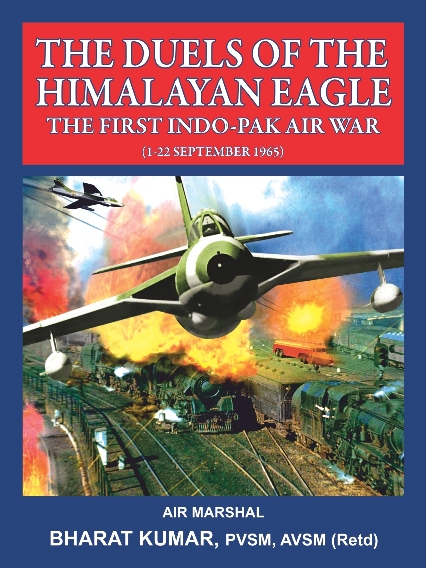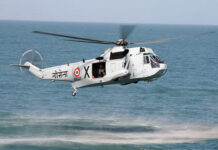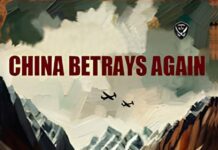IAF Thwarted Operation Grand Slam in 1965
A new book authored by Air Marshal Bharat Kumar, who was a young fighter pilot during the 1965 Indo-Pak War, says that while the Official History of the Ministry of Defence admits that the 1965 war with Pakistan resulted in a stalemate, the IAF came out as the winner. Bharat Kumar’s assessment is based on the fact that Pakistan’s thrust in the Chhamb-Jaurian sector to capture the vital bridge on the River Chenab at Akhnoor, was stopped in its tracks due to the timely intervention of the Indian Air Force.
The book titled “The Duels of the Himalayan Eagle – The First Indo-Pak Air War (1-22 September 1965) was released by the Vice President, Hamid Ansari, at a Tri-Service Joint Seminar on the 1965 War at the Manekshaw Centre here today.
The book, published by Gurgaon-based IMR Media, was commissioned by the Indian Air Force. The author was given access to squadron diaries and official records. Bharat Kumar also relied extensively on personal accounts of the Wing and Squadron commanders as well as fighter and bomber pilots who took part in the missions during the war.
The book has disclosed some hitherto unknown facts and brought them in the public domain.
Having emerged with a beating in the 1962 war with China, India was in the process of expanding its armed forces and buying modern equipment but was nowhere near ready to face the challenge from second and third generation aircraft in Pakistan’s inventory. Pakistan had joint SEATO and CENTO and had been armed by the United States with F-86 Sabre jets and Sidewinder-missile armed F-104 Lockheed Starfighters along with Martin Canberra bombers. On the other hand, the Indian Air Force had the Vampire, Gnat, Hunter, Mystere and Toofani jets. MiG-21s were in the process of being inducted.
Operations in the Kutch Sector
The IAF was not used in any offensive manner during the Kutch crises. It was a political decision not to escalate the conflict unnecessarily.
During Operation Desert Hawk launched by Pakistan, on 19 April 1965, Point 84, Biar Bet, Chhad Bet and Guli Talao were attached. On 20 April, Biar Bet was attacked by a brigade sized force and 30 tanks. Pakistanis suffered heavy casualties and Point 84 and Biar Bet were vacated but they did not occupy them.
On 24 June 1965, Flt Lt RLC Sikka, flying a Toofani, was intercepted by a PAF F-104 Starfighter. One fighter says Sikka surrendered (lowering his undercarriage to show intent) and landed in an open field in Pakistan. Another version says that he ran out of fuel, avoided ejecting and belly landed there.
Operation Gibraltar
Pakistan infiltrated 40,000 specially trained irregular forces into Kashmir on 5 August 1965, led by regular officers, Razakars and Mujahids. They were discovered and rounding up commenced the same day. The PAF was pressed in to support the trapped infiltrators by dropping supplies to isolated bands.
The Army retaliated by occupying some Pak posts across the Ceasefire Line in Kargil, Tithwal and another in Haji Pir Pass. Logistics support was extended by the IAF. From 18 August to 20 September 567 sorties were flown in 433 hours over 36 days
To take on infiltrators entrenched at some posts, Mi-4 helicopters were modified to fire 0.5” Browning gun and drop bombs. The 1949 Ceasefire agreement prohibited the stationing of combat aircraft in J&K. Beginning 31 August, 79 offensive missions were flown to drop 1,131 bombs and fire 5,458 rounds.
Concept of Operations
Pakistan wanted the air superiority battle to be fought at Sargodha-Peshawar, well to the rear for Canberra bombers. It planned on carrying out bomber raids of IAF airfields after having attacked IAF airfields as soon as hostilities commenced.
On the other hand, the IAF was essentially employed in support of the Army. Attacks against Pak airfields were to be carried out only in retaliation. The IAF mainly took on the PAF in the air. Strikes inside East Pakistan were prohibited.
Operation Grand Slam
Pakistan launched Operation Grand Slam on 1 September 1965 at 0600 hrs with an attack in the Chhamb Jaurian sector to capture Akhnur and cut off the life line to the Kashmir Valley. The offensive force consisted of 7 Infantry Division supported by two regiments of armour and Corps Artillery. A diversionary attack was also launched at Jhangar, 56 km north-west of Chhamb. This is how IAF support was provided in world-record time.
The Army asked for air support at 1100 hrs. The COAS, Gen JN Choudhri, who was on a tour in Srinagar, landed in Delhi and proceeded to the office of the Defence Minister where he apprised Air Marshal Arjan Singh, the Cjief of Air Staff, about the situation and requested for air support. Chavan took the political decision at 1650 hours. The first of 26 aircraft got airborne at 1709 hours, an unprecedented record when combat aircraft are launched within 29 minutes.
Pakistan lost ten tanks, two ack-ack guns and 30-40 vehicles in one day. Pakistan advance halted and for all practical purposes Grand Slam defeated.
India’s First Air-to-Air Kill
Flt Lt Trevor Keelor shot down the first Pak F-86 Sabre of the 1965 war. But there was a sad story as well. Sqn Ldr (later Air Marshal) BS Sikand got separated from his Gnat formation, lost contact with his mates and also his bearings. Strangely, at the end of his fuel state, he landed at Pasrur, a disused airfield in Pakistan, which lies in the direction opposite to Adampur, where he was to return. He was taken prisoner.
Attack on Pathankot Air Base
10 Sabres of 19 PAF Squadron from Peshawar, under Sqn Ldr Sayed Sajid Haider, took off on 6 September 1965 while two F-104 Starfighters covered them in the air. They struck Patahnkot airfield at 1715 hrs for over 10 mins. In this raid the IAF lost 6 Mysteres, 2 MiG-21s, 1 Gnat, 1 Packet (all in the open) No airctaft inside the blast pens was damaged. In addition 2 Gnats and 1 Mystere was damaged. Three airmen were injured. Pathankot base had early warning about the attack but it was disregarded.
The whole the attack was going on four Mysteres (led by Flt Lt VM Raina) and two Gnats (led by Flt Lt MR Murdeshwar) were in the process of landing on return from a mission in the Chhamb sector against Pakistani vehicle columns. Two MiG-21s had landed and were being refueled.
Attack on Adampur
Four F-86 Sabres, under Sqn Ldr MM Alam, took off for Peshawar to attack Adampur but missed it and overshot. They spotted three Dakotas (led by Sqn Ldr Dhillon of 43 Squadron flying from Sarsawa to Amritsar) near Phagwara but let them go. Near Taran Taran, the Sabres got involved in a fight with a 4-Hunter formation led by Wf Cdr T Zachariah (and Sqn Ldr MM Sinha, Flt Lt SK Sharma and Sqn Ldr AK Rawlley). The entire engagement was fought out at 150-200 feet AGL and tree-top heights. During the manoeuvres, Rawlley impacted the ground. Alam claimed Rawlley’s Hunter. All three Hunters fired at the Sabres but missed them. Adampur was spared the task of defending itself from the Sabres’ attack.
Attack on Halwara
Four Hunters led by Wg Cdr T Zachariah had landed at 1725 hrs, on 6 September 1965, after a mission and were taxiing back. Meanwhile four Hunters were already airborne providing a combat air patrol (Fg Offr PS Pingale, Fg Offr AR Ghandhi, Flt Lt Rathore and Plt Offr VK Neb). Two out of three Sabres led by Sqn Ldr SA Rafiqui (who had shot down two Vampires on 1 September) struck the Hunters taxiing back. They claimed two Hunters. Soon they got into a fight with Pingale’s combat air patrol. One of the Sabres was shot down by Fg Offr AR Ghandhi. Ghandhi himself was hit by Flt Lt Cecil Choudhary and had to eject. Flt Lt GS Thapa shot down another Sabre with a 20mm aircraft gun being used as a ack-ack gun from the ground.
The Failed Pakistani Air Drop
Pakistan’s plan called for drop of para commandos around three key Indian airfields – Pathankot, Adampur and Halwara.
On the night of 6/7 September, coinciding with B-57 bomber raids, each group of 3 officers, 1 JCO and 60 other ranks, were dropped with auto weapons, mortars, explosives, wireless sets, torches and wire cutters.
At Pathankot, they were dropped at 0230 hours, landed in marshy ground. Villagers discovered them. Sub Area HQ mustered a force of 200 transients and rounded them up by 1000 hours including Maj Khalid Butt.
At Halwara, 60 paratroopers were dropped. Villagers from Rajoana started looking for them and casptured Capt Hassan and two other ranks by morning. A thorough search by Sqn Ldr SK Singh of the Accounts Branch and his men led to the capture of all other para troopers but their commander Major Hazur Hussain managed to get back to Pakistan.
At Adampur, the paratriopers hid in a corn field but were surrounded by the villagers. Some of the paratroopers who were hiding in the sarkanda grass surrendered when they were strafed.
Devayya Gets a MVC after 28 Years
Sqn Ldr AB Devayya, flying a first generation Mystere fighter shot down a third-generation F-104 Lockheed Starfighter. The ‘kill’ was confirmed 28 years later and Devayya was awarded a Maha Vir Chakra, posthumously when a Pakistani pilot confirmed the event.
Flying Officer Dara Chinoy Treks 25 km in One Night
Dara Chinoy’ aircraft, part of four Mystere aircraft formation, was hit by ground fire, caught fire and the engine flamed out. Dara ejected in Pakistan. He managed to evade Pakistani troops and initially moved in Easterly direction. He was followed by Pakistani soldiers. He changed his direction and hid in sugarcane fields for the day. He later trekked 25 km that night and arrived near Amritsar next morning. Had been without food and water for nearly 24 hours.
Dara was interrogated by the Army personnel and after some time his identity was established. He passed out during this journey back to Adampur due to exhaustion but was back to flying the very next morning.
Chief Minister of Gujrat is Shot Down
The Chief Minister of Gujarat, Balwant Rai Mehta, flying in a civilian Beechcraft aircraft, with family, piloted by Jehangir Engineer, one of the famous Engineer brothers of the IAF, was shot down by a Pakistani Sabre jet on 19 September 1965. This was confirmed by the Pakistani pilot, Qais Hussain in August 2011, when he wrote to the Beechcraft pilot apologizing for his mistake.
IAF Raids Badin Radar
Badin had one of the two high-powered radars overlooking the entire southern sector. PAF aircraft were located at Badin and Mauripur airfields. Wing Commander Pete Wilson was nominated to lead strike against the radar.
Six Canberra get airborne from Agra. Fly at height till Bikaner and then ultra-low level to Badin. The first four Canberras bombed Badin with a view to neutralize anti-aircraft defences. The fifth Canberra flown by Wilson flew at extremely low level and attacked the radome from below with rockets and blows up the radome.
The last Canberra was to perform dual role. First to act as decoy if Wilson encountered any enemy aircraft and secondly to be standby to Wilson if something happened to Wilson. In this case, no such action required. All aircraft return to base. Badin put out of action.


















